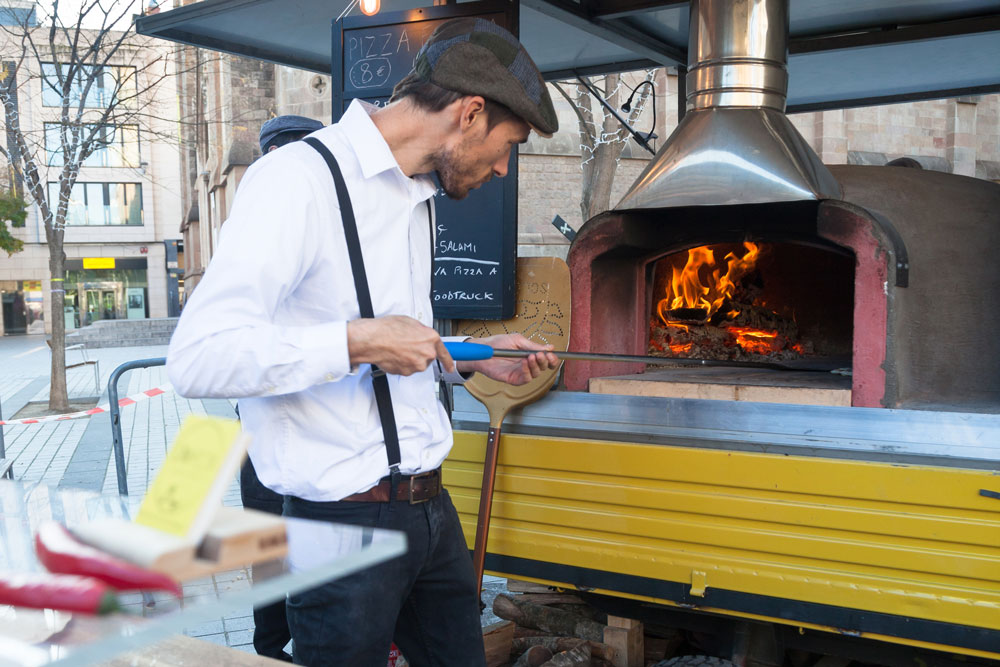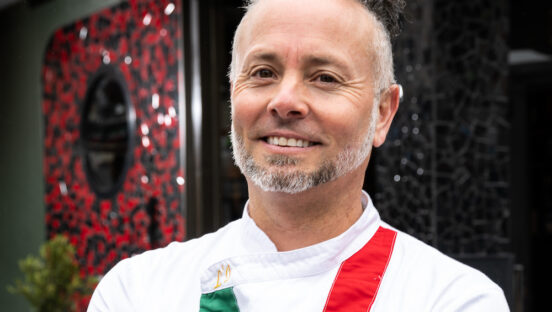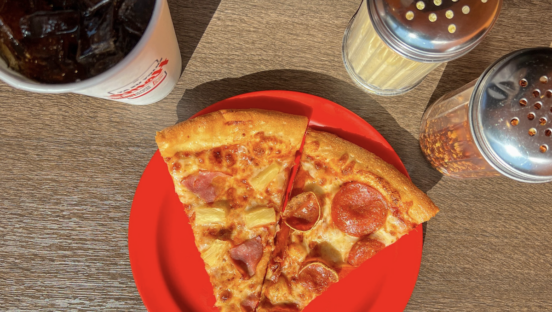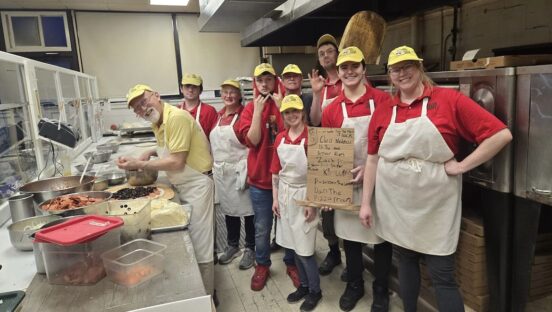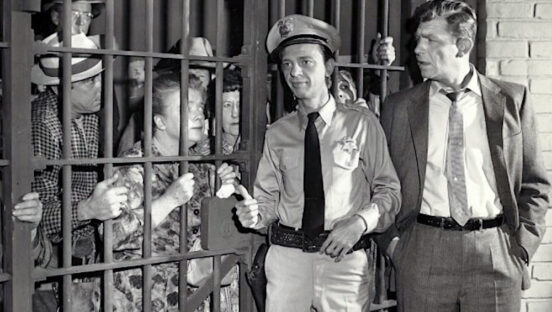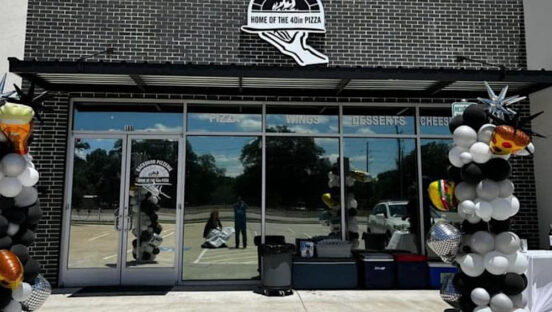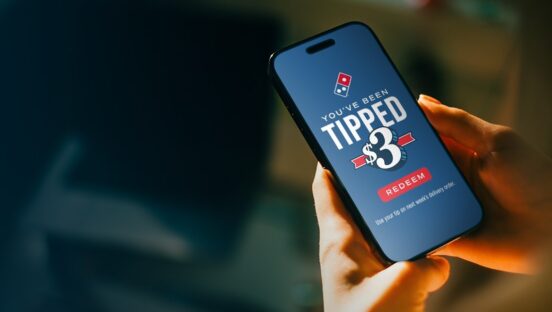By Tracy Morin
Mobile businesses can seem to launch overnight success with less risk and commitment than a brick-and-mortar business, but they have their own complications and considerations. “Going mobile is not as easy as purchasing a portable oven and getting started—you need to consider permitting, transportation, marketing, equipment, weather and a number of other things,” warns Conor Cudahy, owner of Boston-based Lala’s Neapolitan-ish Pizza. “It should be given the same amount of thought and consideration as a brick-and-mortar restaurant.”
Still interested? Read on for more tips from operators, in their own words, who have taken their mobile businesses to incredible heights.

Lala’s Neapolitan-ish Pizza in Boston was able to leverage its mobile success to land in a brick-and-mortar location—a move that may or may not be a mobile owner’s ultimate goal. Photo by Nicole Melich.
Conor Cudahy, owner, Lala’s Neapolitan-ish Pizza, Boston, MA
Over the last two years, we have learned more than I could have imagined: Obtaining temporary operating permits can be a real pain in the butt (and expensive!); choosing a commissary kitchen with a large mixer will make your life infinitely easier; the weather can be your worst enemy or your greatest friend; relationship building is essential; and good cheese is worth the money.
We just hired an accountant to help keep our books up to date. We are always looking for ways to keep our dough at temperature on cold/hot days, and we invested in a mobile refrigerator to avoid the cost of ice. It’s also important to remember that if you don’t give your employees a living wage, proper training and a respectful workplace, they will not be working there long, and the time you spent training them will be wasted.
“If you don’t give your employees a living wage, proper training and a respectful workplace, they will not be working there long, and the time you spent training them will be wasted.”
— Conor Cudahy, Lala’s Neapolitan-ish Pizza
Opening a brick-and-mortar was always our goal, so we were constantly on the lookout for places to move into. We are now opening in Time Out Market Boston, a food hall—a great next step for Lala’s for several reasons. The kitchen was already completely outfitted with an oven and refrigeration. They do a great job marketing and attracting new customers, and they have a steady amount of foot traffic coming in their doors all day long. The low risk/high potential of opening made it hard to pass up.
Once we have our brick-and-mortar and mobile operations running efficiently, it will be time to look for a spot of our own. Whether it’s a sit-down spot, fast casual, or something in between, we’ll always keep an eye out for a great space.
Related: Doing the math of mobile pizza operations

Siler Chapman, owner of King of Fire, puts only his company’s name, not a website, on the vehicle. Photo courtesy King of Fire.
Siler Chapman, owner, King of Fire, Fort Mill, SC
I had 15 brick-and-mortar pizzerias, but I wanted to have something as a side hobby and started to see the potential in mobile pizza. I got a trailer from Fire Within, started a little catering company and fell in love with the model while doing weddings and private events starting in October 2018. COVID-19 helped us take off—as private events and brewery visits stopped, we set up in neighborhoods. People preordered pizzas and drove up for almost-contactless pickup. Suddenly, every neighborhood in a 30-mile radius wanted us, and we couldn’t service everyone, so we got two more trailers, then two more! Now, we have six operating, and online preorders are 98% of our business. On the weddings side, we did 36 in 2019 and are already on target for 150 in 2023.
Related: PMQ Road Trip: Behold, the King of Fire!
Brick and mortar has a lot of fixed costs, so, with mobile, you can do half the sales and get more profit. But with mobile, there are a lot of moving parts—you might get a flat tire, break down, etc.—so it’s a lot of work with a lot of surprises. There’s a lot more that can go wrong, and it can happen quickly. The No. 1 thing is to have a backup: spare tire, POS system, sauce ladle, utensils, wood, 20-ton jack. Have a backup of a backup of every single thing. Something is going to go wrong, but the customer can’t know that.
“Brick and mortar has a lot of fixed costs, so, with mobile, you can do half the sales and get more profit.”
— Siler Chapman, King of Fire
At first, we didn’t do any marketing, as wedding vendors would recommend us and we had great word-of-mouth. We have a phone number but no website on our truck, because we want people to Google us. Now, we’ll post on a Facebook or Instagram group that we have a truck available, and we’ll get 30 gigs from one post! But you have to build those relationships with people and hook them with great food.
We now have someone on staff doing social media, since we’re building a brand. We believe that slow growth is permanent growth. Each truck is run like its own restaurant—we have a commissary with a kitchen manager, and each truck is accountable for its own food and labor, and each is bonused based on performance. We want to grow to eight units in the Charlotte, North Carolina, market and then to other cities, like Raleigh and Atlanta.
Get a phenomenal education on how to make a great pizza, then get a good education on how to operate a business, because today’s times are tough, and you really have to understand the dynamics of the industry. Having both of these will help you dominate, whether you’re in mobile or brick and mortar. Average is not a thing anymore—nowadays, you’ve gotta be great to survive.

Alessio Lacco and Sofia Arango, owners of Atlanta Pizza Truck, have used their mobile unit to cater to the stars on a slew of television and movie sets. Photo courtesy Atlanta Pizza Truck.
Alessio Lacco, owner, Atlanta Pizza Truck, Atlanta, GA
In the pandemic, I was laid off as general manager of a pizzeria, and my wife, Sofia Arango, was a server in restaurants. We had the idea to sell pizza in neighborhoods, so we posted on Facebook groups. Our pop-ups became popular, and people started asking if we could do birthdays, graduations and weddings. Now, we’re well-established, so we do only private events. Last year, we started to cater movie sets and TV shows.
The main problem was finding people to work. The first year, Sofia and I did everything: making the dough, prep, cleaning, organizing—it was basically a 24-hour job. With catering, there is no fixed schedule, so I couldn’t offer a 40-hour week. But employees found they can do 30 hours and make good tips. We hired Uber or DoorDash drivers—they know their way around the city, and I can teach them how to be pizza makers. We give them good pay, bonuses, gift cards—and they like working on movie sets and at events, because it’s fun. We make sure they want to grow with us. Now, we have three mobile units and do three to five events a day.
“We have an Associazione Verace Pizza Napoletana (AVPN) certification—the first truck to get certified—which gives us a lot of credibility and trust.”
— Alessio Lacco, Atlanta Pizza Truck
It’s very important to show up on time and be reliable. We have an AAA membership in case we need help changing a tire, and we have a GPS in every vehicle. You have to be cautious with insurance, and we have a commercial kitchen to prep everything. Because people pay in advance, we know the exact labor and food costs and quantities.
When we started, we had only pizza, but as we grew, we added salads, bruschetta, meatballs, pastas—plus homemade gelato from the company that shares our commercial kitchen space. So we offer full catering, not just a pizza truck. We do Facebook, Google and newspaper ads. Venues, event planners and other mobile operators (like taco trucks or mobile bars) that we have worked with recommend us. We also have an Associazione Verace Pizza Napoletana (AVPN) certification—the first truck to get certified—which gives us a lot of credibility and trust. We are looking to grow into other cities through franchising, and we’re in talks with a local brewery to open an 800-square-foot location inside their business. It’s all about partnerships.

Diana and Mike Wagner cater to customers who moved to Alaska from all over the U.S., so they make sure to offer a wide variety of regional pizza styles at Wagner’s Pizza Bus. Photo courtesy Wagner’s Pizza Bus.
Michael Wagner, Wagner’s Pizza Bus, Fairbanks, Alaska
What’s funny about pizza in Fairbanks is that every restaurant and food truck owner thinks they need to sell pizza. So, with a population of around 33,000 people, there are over 50 different places to get pizza. We offer more than 30 regional pizza styles, including Detroit, Chicago, Old Forge, St. Louis, Sicilian, etc. We started doing regional pizzas a few years ago, because no one up here did that and most of the people up here are from all over the country, so why not offer pizzas they remember eating while growing up?
“We offer more than 30 regional pizza styles, including Detroit, Chicago, Old Forge, St. Louis, Sicilian, etc. Most of the people up here are from all over the country, so why not offer pizzas they remember eating while growing up?”
— Michael Wagner, Wagner’s Pizza Bus
It’s next to impossible to get brick cheese for our Detroit-style pizza in Fairbanks, so we have to substitute another cheese to get the same result. It’s the same with Provel cheese for our St. Louis-style pizza. I’m still trying to figure out how to make the Denver Mile High pizza. I’ve made several that taste good, but it’s the twisted crust I need to work on. We picked up a wood-fired oven to add that style of pizza, plus the New Haven apizza style, too. And we just learned about the Milwaukee style this month.
Related: Wagner’s Pizza Bus serves 30 regional styles in wild Alaska
This year, we ordered special pans from Lloyd Pans to offset [a price increase] for our customers. When we raised our pizza prices, we made the pizzas 1” bigger. So our 12” is now 13”, our 16” is now 17”, and our 18” is now 19”. But to stay open, we will have to raise pizza prices again, and we already feel we will lose some customers—which is another reason we started making regional pizzas. We are the only pizza shop in Alaska with that many. In just the last couple of years, others have added Chicago deep-dish, Detroit and Sicilian pizzas to their menus, and you know what happens when a gas station opens across the road from another gas station: They both lose money. Same here. Then, with inflation on top….Time will tell if it works out for us.
Tracy Morin is PMQ’s senior copy editor and the editor of PizzaVegan.com.

